When carrying out electrical work, the master needs to know which side of the phase is in the outlet. If you ignore this moment, with a de-energized network, a person can receive a strong electric shock. An indicator above 50 V is already considered dangerous for a living organism. And the phase contains all 220-240 Volts.
How to determine which side is zero and phase
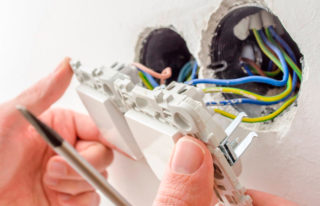
Initial data can be obtained by carefully looking at the colors of the wires connected to the socket terminals. Each of them has its own meaning:
- green, yellow-green - grounding;
- blue or white-blue - zero;
- all other colors (black, brown, white, red) - phase.
But this can only be tracked with a disassembled power point. If you need to find out the operating parameters of the socket as a whole, it is recommended to use special measuring devices.
Phase and zero in old sockets
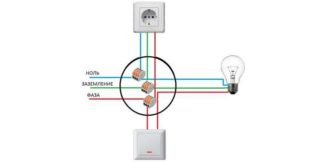
When arranging power points of the old model, the above principle of installation by wire colors was used. Blue or blue and white is always zero. If you touch it with your hand, but do not touch the second wire in parallel, an electric shock will not happen.
To connect the phase, wires of other shades are used, except for green or yellow-green. Here, touching a conductor threatens an accident.
Zero and phase for modern sockets
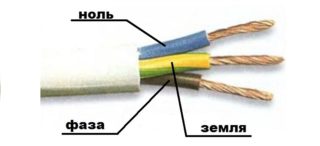
The phase and zero in the new type of socket are identical to the above example. But here more often the ground wire is added. It is needed in order to redirect excess current from the supply point to ground or back to the network. The user is provided with additional safety in the event of electrical problems.
It is especially important to ground the sockets in the bathroom and kitchen (for powerful cooking / oven appliances).
The location of zero and phase is not of fundamental importance. The power point will work anyway. But more often the masters secretly place zero on the right, and the phase on the left.
Determination of parameters with instruments
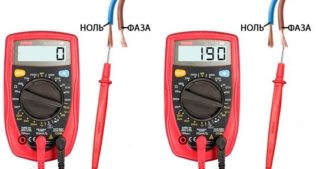
You can determine where the phase should be in the outlet by using a multimeter or an indicator screwdriver.
The first is a multifunctional device with which you can monitor the voltage, AC and DC current, resistance, etc. There are both analogue and digital multimeters. The latter give more accurate readings.
To carry out measurements and determine the phase in the outlet, the device is switched to the mode of measuring the AC voltage. Turn the control wheel to the ACV or V ~ scale. Then they act like this:
- A red test lead is connected to the VΩmA connector. You need to touch it only for the rubberized winding. The VΩmA connector is designed to detect resistance, voltage, current.
- The probe is inserted into the socket and the data on the screen is monitored. If the wire is brought to zero, the data will be absent or will show no more than 10 V. If the probe is inserted into a phase, the dial will display a value of 220-240 Volts.
According to GOST, deviations of 20% in one direction or another are permissible for the household network.
Before starting work, the regulator on the multimeter must be set to 750 V. It is advisable to work with the device with rubberized gloves. If there is a microcrack on the winding of the probe, the master may receive an electric shock.A device with obvious damage to the case or wires must not be used.
Indicator screwdriver
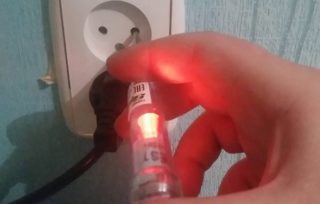
The small tool looks like an ordinary screwdriver. The only difference is that its metal part is a conductor, and a diode is built into the transparent polymer handle. It reacts to mains voltage and shows the reaction with a backlight.
It is impossible to use the indicator screwdriver for other purposes. This can damage the conductor or diode.
The measurement is performed as follows:
- The metal end of the screwdriver is inserted into the socket and touches the contact with it.
- At the same time, the button is pressed from the side of the handle. A lit LED indicates the presence of a phase in the socket. The lack of backlighting indicates that the master has hit zero.
The indicator screwdriver is capable of responding to voltages from 50 to 380 volts.
For safe and correct operation of the tool, it is prohibited:
- touch the metal tip with your fingers while measuring;
- wet the screwdriver or keep it covered in dirt.
It is advisable to always have such a tool at hand.
The second phase in the socket
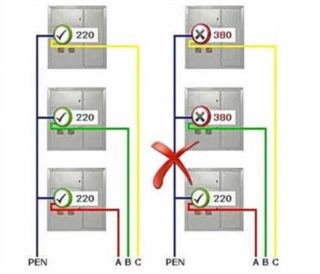
It sometimes happens that the master detects two phases (in each slot) during the test. More often the reason for this is:
- damage to the neutral wire in one of the sections (for example, recent wall drilling);
- voltage drops in the network during bad weather.
You can solve the problem simply by turning off all the appliances in the house and then turning it on or by restoring the damaged section of the zero wiring. The wizard's actions depend on the cause of the accident.
The danger of two phases according to the PUE lies mainly for a person. Household appliances will simply not work with such a network. The tenant of an apartment or house, in the presence of two phases, is threatened with a strong electric shock from any metal surface (the body of a refrigerator, microwave oven, boiler, etc.). The excess phase passes through the load to the neutral wire and moves to the ground wire, then flows to the metal case of household appliances.
If you touch the device with your hand during two phases, irreparable damage may occur. Therefore, you need to fix the problem as soon as possible if the wizard finds out about it.








